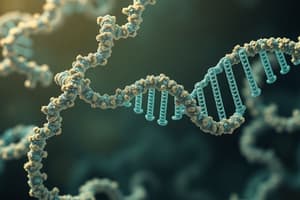Podcast
Questions and Answers
What is the main focus of the Amino Acid-Nucleotide Interaction Database (AANT)?
What is the main focus of the Amino Acid-Nucleotide Interaction Database (AANT)?
- Studying the relationship between proteins and nucleotides
- Categorizing experimentally determined amino acid-nucleotide interactions (correct)
- Predicting hydrogen bonds between amino acid residues
- Visualizing amino acid-nucleotide interactions
In the context of DNA, what role do amino acids and DNA play?
In the context of DNA, what role do amino acids and DNA play?
- They aid in predicting hydrogen bonds
- They help visualize nucleotide moieties
- They primarily focus on protein structures
- They are crucial components in protein-nucleic acid interactions (correct)
How does AANT categorize interactions between amino acids and nucleotides?
How does AANT categorize interactions between amino acids and nucleotides?
- Using software to predict interactions
- By assigning interaction classes (correct)
- Based on hydrogen bond strength
- Identifying peptide backbone configurations
Which software does AANT use to predict hydrogen bonds between nucleotide and amino acid residues?
Which software does AANT use to predict hydrogen bonds between nucleotide and amino acid residues?
How many possibilities are there for the amino acid moiety when assigning interactions in AANT?
How many possibilities are there for the amino acid moiety when assigning interactions in AANT?
What is the significance of understanding amino acid-nucleotide interactions?
What is the significance of understanding amino acid-nucleotide interactions?
Which atoms in a nucleotide residue are involved in individual interactions with amino acid residues?
Which atoms in a nucleotide residue are involved in individual interactions with amino acid residues?
What do arginine and lysine strongly favor in terms of bases?
What do arginine and lysine strongly favor in terms of bases?
How are entries in the database classified based on hydrogen bond geometries?
How are entries in the database classified based on hydrogen bond geometries?
Which amino acids prefer adenine in amino acid-base hydrogen bonds?
Which amino acids prefer adenine in amino acid-base hydrogen bonds?
How is the strength of interaction between amino acid side chains and nucleotides evaluated?
How is the strength of interaction between amino acid side chains and nucleotides evaluated?
Which amino acids produce less than the expected number of interactions due to unfavorable electrostatic interactions with DNA?
Which amino acids produce less than the expected number of interactions due to unfavorable electrostatic interactions with DNA?
Flashcards are hidden until you start studying
Study Notes
Amino Acids and DNA
Protein-nucleic acid interactions play a crucial role in the functioning of biological systems, with amino acids and DNA being key components in these interactions. These interactions, which are essential for various cellular processes, have been studied extensively to understand the complex relationships between proteins and nucleotides. In this article, we will discuss the amino acid-nucleotide interactions and their significance in the context of DNA.
Amino Acid-Nucleotide Interactions
The amino acid-nucleotide interaction database (AANT) is a comprehensive resource that categorizes all amino acid-nucleotide interactions from experimentally determined protein-nucleic acid structures. AANT extracts individual interactions from structures in the Protein Data Bank (PDB) and combines them into structure files, allowing users to visualize these interactions in aggregate. The database assigns each interaction to an interaction class, defined by the attributes of the interaction involved: the nucleotide (five possibilities), the nucleotide moiety (base, sugar, or phosphate; three possibilities), the amino acid (20 possibilities), and the amino acid moiety (side chain or peptide backbone; two possibilities).
Interaction Super-Models
AANT uses the software HBPLUS to predict hydrogen bonds between single nucleotide residues and single amino acid residues. The bonded structures are broken into scores of individual interactions between the base, the sugar, or the phosphate of a nucleotide residue and the side chain or peptide backbone of an amino acid residue. AANT then transforms each interaction into a new coordinate system, centering on a fixed atom in the nucleotide moiety involved (base, sugar, or phosphate), while keeping the internal geometry of the interaction intact.
Amino Acid Propensities
Amino acid propensities for various components have been studied to better understand the interaction between amino acids and bases. For example, arginine and lysine strongly favor guanine, while asparagine and glutamine prefer adenine. These preferences are not exclusive, and these amino acids also interact with other base types, albeit less often.
Hydrogen Bond Geometries
Entries in the database are classified into single interactions, bidentate interactions, and complex bonds, based on the hydrogen bond geometries involved. The distribution of bond types is summarized in Table 3.3, with 131 being in single, 120 in bidentate, and 121 in complex interactions.
Favored Amino Acid-Base Hydrogen Bonds
There are clear preferences for particular pairings of amino acids and bases. Arginine and lysine strongly favor guanine, while asparagine and glutamine prefer adenine. The combinations are not exclusive, and these amino acids also interact with other base types, albeit less often.
Hydrogen Bond Strengths
The strength of interaction between amino acid side chains and nucleotides is evaluated from atomic contacts of the nodes, with the interaction strength (Iij) being evaluated in a manner similar to that adopted in the case of protein-protein interactions.
Complex Bonds
Some amino acids produce less than the expected number of interactions, such as glutamate, alanine, leucine, and aspartate. The distributions of these acidic residues are due to unfavorable electrostatic interactions with the DNA.
In conclusion, the study of amino acid-nucleotide interactions is crucial for understanding the complex relationships between proteins and nucleotides. Databases like AANT provide valuable insights into these interactions, which can help in the design of altered or novel protein-nucleic acid interactions.
Studying That Suits You
Use AI to generate personalized quizzes and flashcards to suit your learning preferences.



